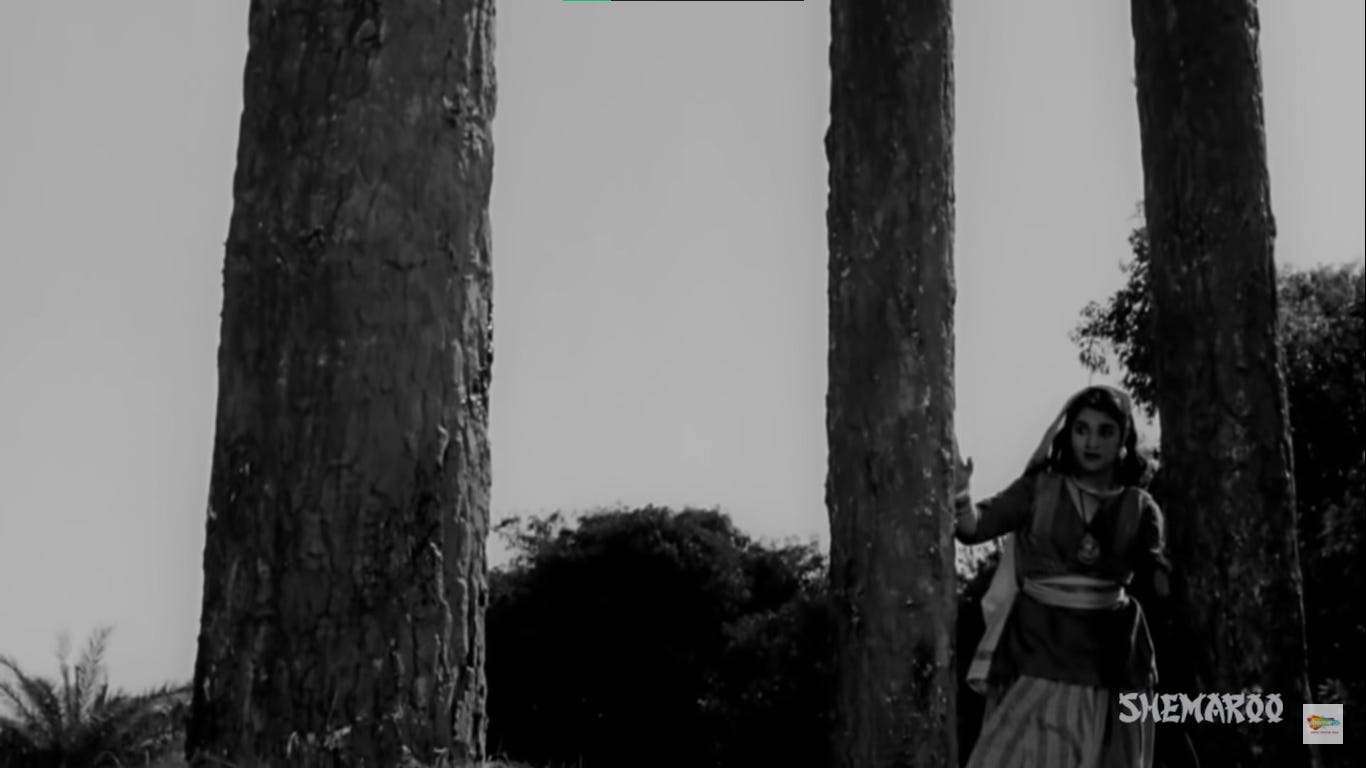Madhumati - Finding Frames.
and the Filmfare for the most abrupt song beginnings goes to...
I saw the 1958 film Madhumati recently. The film is very good and extremely watchable despite an almost three hour runtime, and Dilip Kumar and Vyjayanthimala under-acting and over-acting respectively.
November 9 this year will mark the 15th year anniversary of Om Shanti Om (and Saawariya - we can save that for another article). In the lead up to its anniversary, I want to watch all the films that inspired its making. Well, all the films that DIRECTLY inspired its making. Madhumati is one such film. The climactic showdown where the evil rich guy gets his comeuppance is the same in both films.
Production, Background & Team
Dilip Kumar and Vyjayanthimala had both acted in Bimal Roy’s Devdas (1955). Devdas was not commercially successful and Bimal Roy Productions was looking for a mainstream commercial hit for his next venture.
The story of how Devdas got made is also interesting. Bimal Roy wanted Meena Kumari to play Paro and Nargis to play Chandramukhi. Kamal Amrohi, who was married to Kumari interfered and had a falling out with Roy. Amrohi apparently did not like Dilip Kumar. Mina Kumari was keen on playing Paro, but alas. Kumar opposite Kumari would have been a really funny credit sequence (I know they starred opposite each other in atleast one film which has a really interesting premise). Nargis also backed out as she wanted to play Paro. Ultimately Suchitra Sen would make her Hindi film debut as Paro and Vyjayanthimala would play Chandramukhi. That Vyjayanthimala was a well regarded daneuse, helped nudge the casting choice.
That’s a big digression. Anyway.
The team behind Madhumati is truly stellar. Bimal Roy and his go-to cinematographer Dilip Gupta use mist, water and silk curtains to highlight the ethereal quality of the story very well. Trees, shadows and clouds set-up an eerie atmosphere. The same trees, shadows and clouds also soothes, when Mukesh, Lata, Asha or Manna Dey take center stage. The story and screenplay are by the great Ritwik Ghatak, and dialogues by Rajinder Singh Bedi. Hrishikesh Mukherjee won the best-editor Filmfare for Madhumati.
[Mukherjee would win his second Filmfare for editing in 1970, for Bedi’s directorial debut - Dastak. Bedi, Mukherjee, Ghatak had previously collaborated on the brilliant film Musafir (1957). The film was Mukherjee’s debut as director, and also stands distinctly in his oeuvre for its content. Dilip Kumar was the lead in Musafir as well. ]
Madhumati today is known as one of the first reincarnation story. But, I would like to posit that it is only the first revenge-reincarnation love story. Bimal Roy had edited Kamal Amrohi’s 1959 film Mahal, which was a reincarnation love story, perhaps the first of its kind. Falling portraits and abandoned havelis are common elements in the two films. Karz (1980) and Om Shanti Om (2007) both directly inspired by Madhumati are reincarnation-revenge love stories. The revenge takes place after the reincarnation it these films, hence the distinction.
Themes
Dilip Kumar and Vyjayanthimala are the time-transcending, janam-janam-ka-pyar having Anand and Madhu. Anand is the newly appointed upstanding manager at a timber estate owned by a spoiled brat,and run by goons and cheats. Madhu is the daughter of the tribe leader, who lives across the river where company men are not allowed to go. The tribe and company men have clashed before, where the tribe was effectively crushed. The leader is a leader in name only, and the tribal folk live diminshed lives at the mercy (or lack thereof) of the company goons. Madhu represents nature herself, and the raja sahib/company owner is of course a stand-in for exploitative capitalism.
Finding Frames
The film has a lock camera —> character-enters frame —> dialogue/action —>either moves towards camera or away from camera —> exits frame style; and it works quite well. I know this sounds like any other film, but that is the best way I can articulate the direction style.
Here are some of my favourite frames from the film.
All songs are very well done, but this one is the most visually interesting
So many trees in the film. Really beautiful
the devilish Rajasahib (Pran) enjoying a nautch performance
Anand looks for Madhu as the haunting song Aaja Re Pardesi plays, which is used as a liet motif for Madhu’s character, and later her memory/ghost
a distressed Anand looks for her wife and newborn kid who were passengers in a train that met with an accident
Watch Madhumati on YouTube, JioCinema, or Zee5
BYE. :)






